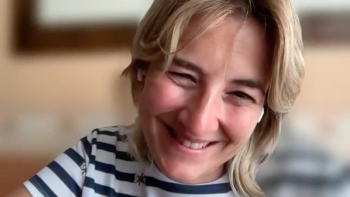
Annual Clinical Update on MDS Sees Hope in Precision Medicine, Use of Oral Therapy
An overview of the 2023 recommendations on myelodysplastic syndromes by Guillermo Garcia-Mareno, MD, of MD Anderson Cancer Center, appears in the August issue of the American Journal of Hematology.
The Annual Clinical Update in Hematological Malignancies, appearing online in early June and now publishing in the August issue of the American Journal of Hematology (AJH), includes an update on
“Better understanding of the pathobiology of MDS is resulting in newer approaches for patients,” Garcia-Manero states. “As a consequence, the treatment landscape for patients with MDS is starting to change.”
The update notes that patients’ prognosis is classified with different scoring methods, which all include an evaluation of the percentage of blasts in the bone marrow, peripheral cytopenias, cytogenic characeterics. A
The article presents a treatment algorithm based on lower-risk or higher-risk classification, but it does call for next-generation sequencing at baseline “and each time a therapeutic decision is going to be made,” because there is no other way to identify small subsets of patients who are more likely to have a response to specific treatments, such as allogeneic stem cell transplant (alloSCT), based on their genomic profile.
Garcia-Manero cited a report on a small group of patients at MD Anderson with very high response rates based on this approach.
Early-stage conditions. The article distinguishes betweenclonal cytopenia of undetermined significance (CCUS), clonal hematopoiesis of indeterminate potential (CHIP), and idiopathic cytopenia of undetermined significance (ICUS), in which dysplasia is not seen but the potential for progression to MDS exists. At this stage, Garcia-Manero writes, “Patients with ICUS/CHIP/CCUS should not be treated but followed preferentially in a dedicated ‘CHIP’ clinic.
Attention should be paid to the care of comorbidities. Clinical trials could be considered if available.”
Lower-risk MDS. Garcia-Manero hedges his recommendations in this section by noting that things could change with results from the COMMANDS trial,
The article’s section on lower risk MDS also discusses use of lenalidomide and azanucleosides, including oral decitabine/cedazuridine (oral dec/ced), approved in 2020. Garcia-Mareno said use of these agents in the US is mainly in second-line treatment and different from use in Europe. He discusses at length the importance of proper dosing; at MD Anderson, investigators designed a series of clinical trials investigating attenuated doses and schedules of both azacytidine and decitabine. When these trial designs were criticized for not including comparisons of hypomethylating agents (HMAs), a third study was designed and is accruing patients.
Garcia-Mareno notes that use of HMAs in lower-risk MDS is better facilitated with the availability of oral agents; the recommendation sees more use of oral agents in the future. Thus far, data on oral dac/ced and oral azacytidine have been published, although the latter is not approved in MDS. He notes that the phase 3 trial for oral dec/ced directly compared patients to intravenous decitabine, and “This allowed for intrapatient PK comparison. Results presented at [American Society of Hematology] 2019 demonstrated virtually identical pharmacokinetic (PK) profile between both IV decitabine and the oral version.” The article outlines ongoing studies in both agents.
He mentioned the phase 2/3 iMerge trial (NCT02498661), also presented at ASCO, in which imetelstat, a telomerase inhibitor, produced a significantly higher rate of 8-week transfusion independence than placebo. Since then, FDA has granted a
Another section of the paper addresses treatment of patients with lower-risk MDS and thrombocytopenia.
Higher-risk patients. Garcia-Mareno writes that options for patients diagnosed with higher-risk MDS “have not evolved significantly” since the last AJH update, and that “azanucleosides remain the standard of care of a majority of patients.” He wrote that final results for the study (
Although the paper notes that “no study has compared 5-azacitidine vs decitabine” and response rates appear similar, “only 5-azacitidine has been associated with improvement of survival in a randomized trial. Based on this, we consider 5-azacitidine standard therapy for front-line treatment in higher risk MDS.”
Garcia-Mareno goes on to outline when patients should be considered for therapy similar to that used to treat patients with acute myeloid leukemia, such as an allogeneic stem cell transplant (alloSCT); for lower-risk MDS, generally younger, fitter patients would be considered. The algorithm for higher-risk patients distinguishes between those older and younger than aged 70 to 75, when an individual’s ability to tolerate various treatment approaches must be weighed against possible benefits. Recommendations regarding alloSCT are very specific in the higher-risk population: “Although alloSCT should be considered for patients with higher-risk MDS this may not be the case in patients with high risk mutations such as TP53, in whom, in our opinion, transplant may have to be considered only if an optimal donor is available.”
Still, the challenge of what to do for patients who fail HMAs is a daunting one, and Garcia-Mareno concludes with a discussion of the “total therapy” approach alongside alloSCT, including the debate over bridging therapy. "The advent of powerful new combinations with magrolimab or venetoclax argue for total therapy that could render patients [minimal residual disease]-negative pre transplant followed with post-transplant maintenance therapy, either with targeted approaches of HMAs. Further studies are needed in this area.”
Reference
Garcia-Manero G. Myelodysplastic syndromes: 2023 update on diagnosis, risk-stratification, and management. Am J Hematol. 2023;98(8):1307‐1325. doi:10. 1002/ajh.26984
Newsletter
Stay ahead of policy, cost, and value—subscribe to AJMC for expert insights at the intersection of clinical care and health economics.





































